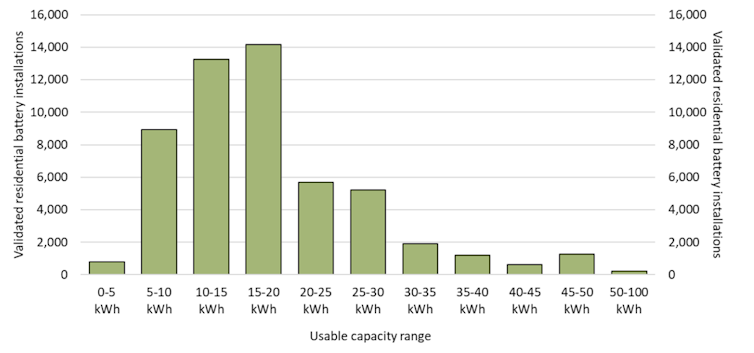Australia’s $2.3 billion green energy program is funding oversized batteries and blowing out in cost
- Written by Rohan Best, Senior Lecturer, Department of Economics, Macquarie University

A federal government green energy program is subsidising unnecessarily large home batteries and blowing out in cost.
The Labor government launched its A$2.3 billion Cheaper Home Batteries Program[1] in July, with the aim of bringing down household power bills and reducing people’s reliance on the energy grid. The program was projected to lead to more than 1 million installed batteries by 2030.
There has been a massive uptake. The Clean Energy Regulator, which administers the program, told The Conversation that around 146,000 batteries have been installed in just five months.
But digging into the data reveals some major concerns about the program – many of which I previously anticipated[2]. The average size of the batteries installed under the program is roughly double what a regular household requires to meet its energy needs. And that has resulted in a major cost blowout.
But there are ways to fix the program and ensure its benefits are distributed fairly among Australians.
What exactly is the Cheaper Home Batteries Program?
The program provides discounts of around 30% of the cost of an installed battery.
These batteries are valuable to store the excess energy from millions of rooftop solar systems in Australia. As such, they are an important component of the renewable energy transition.
The federal government has been celebrating the popularity of the program.
In September, when the Clean Energy Regulator revealed 50,000 batteries had been installed in just two months, Minister for Climate Change and Energy Chris Bowen said[3]:
This program is working in the suburbs, in the regions and in our cities. Australians are proving the naysayers and climate change deniers wrong – they want to be part of the clean energy future.
Early warnings have come true
In April I warned[4] about the potential problems with the program if it wasn’t properly targeted, including that it would give higher subsidies for larger batteries which could, in turn, lead to major cost blowouts.
These warnings have come true.
The Clean Energy Regulator told The Conversation that as of December 3, “there are currently around 146,000 batteries installed under the Cheaper Home Batteries Program”.
By the end of the year, it expects[5] this figure to rise to around 175,000.
More than 98%[6] of batteries have been installed for households, with businesses making up most of the rest.
The average system size of battery installation is more than 22 kilowatt-hours, which can cost around A$18,000[7]. The most common system size installation is roughly 19kWh.
More than 80%[8] of validated residential battery installations have been above 10kWh.

For perspective, a typical household battery is around 11kWh[10], which can cost around A$10,000[11]. And a battery as small as 5–6kWh[12] could be sufficient to store energy in the middle of the day that can cover much of the evening peak for most households.
As of December 3, the program had cost roughly A$749 million, according to a spokesperson for the federal Department of Climate Change, Energy, the Environment and Water.
This means around 30% of the cash pool has been spent on less than 15% of the projected 1 million batteries.
At this rate, the budget allocation of $2.3 billion might therefore run out in 2026, rather than 2030 as originally planned[13].
If this trend continues, and government budget allocations are extended, the total cost of the program could blow out to around $10 billion.
However, projections are vexed in general and there are reasons why the future will not be identical to the past. For example, the discounts per kWh are designed to decrease toward 2030[14], in line with assumptions of battery cost reductions.
So, what now?
The government says[15] it is “working carefully […] on how to deliver on our objectives and keep the program sustainable for years to come”.
This could include adjusting the program to lower discounts for large batteries.
Currently, batteries above 100kWh are ineligible, and batteries above 50kWh only get a discount with respect to the first 50kWh. A possibility to discuss is lowering the 50kWh threshold to 15kWh.
Means testing could also be introduced, as is the case in some state[16] schemes.
Means testing can refer to assets, such as property values used by Solar Victoria[17], with potential to use financial assets like for the age pension[18].
This could help to direct subsidies to the people who need them most.
Co-mingled schemes including multiple technologies, like in the Australian Capital Territory[19], could also give households more flexibility and provide a genuine opportunity for renters.
The success of this program can’t just be about how many new batteries are installed. It must also be about cost-effectiveness and fairness.
And on that front, it’s clear there’s plenty of work to be done.
References
- ^ Cheaper Home Batteries Program (alp.org.au)
- ^ previously anticipated (theconversation.com)
- ^ said (minister.dcceew.gov.au)
- ^ warned (theconversation.com)
- ^ expects (cer.gov.au)
- ^ More than 98% (cer.gov.au)
- ^ around A$18,000 (solarsuperstore.com.au)
- ^ More than 80% (cer.gov.au)
- ^ Clean Energy Regulator (cer.gov.au)
- ^ around 11kWh (australian.museum)
- ^ around A$10,000 (solarsuperstore.com.au)
- ^ 5–6kWh (australian.museum)
- ^ 2030 as originally planned (alp.org.au)
- ^ discounts per kWh are designed to decrease toward 2030 (www.dcceew.gov.au)
- ^ says (www.dcceew.gov.au)
- ^ state (www.wa.gov.au)
- ^ property values used by Solar Victoria (www.solar.vic.gov.au)
- ^ age pension (www.servicesaustralia.gov.au)
- ^ Australian Capital Territory (www.climatechoices.act.gov.au)



















